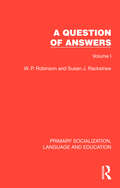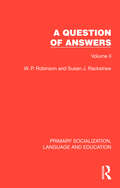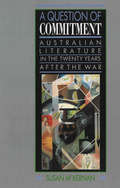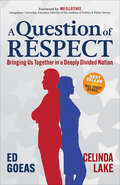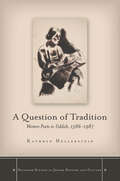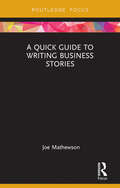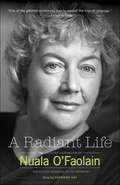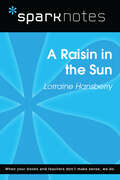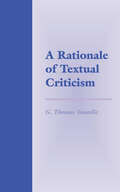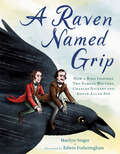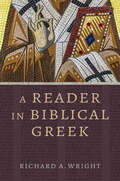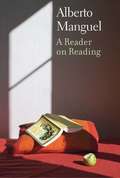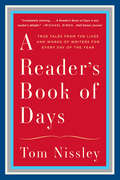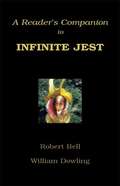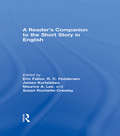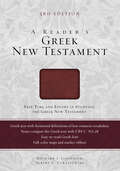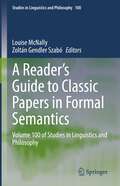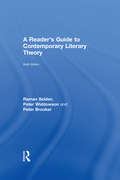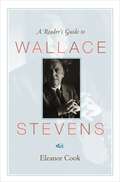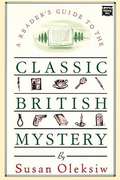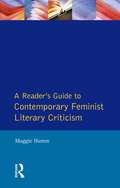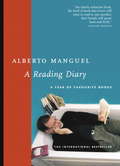- Table View
- List View
A Question of Answers: Volume I (Primary Socialization, Language and Education)
by W. P. Robinson Susan J. RackstrawIn the early 1970s, the problem of arousing and maintaining the curiosity of children had been a recurrent theme in reports concerned with the development of new school curricula. However, before these ideas could be translated into soundly based practical measures, an increased understanding of what is involved in the activities of questioning and answering was needed.Originally published in 1972, the research reported in these two volumes presents a theoretical framework for describing linguistic features of a range of verbally expressed answers and their associated questions. Basil Bernstein’s theory is used to generate a number of predictions about the variety and quality of answers that mothers and children are likely to offer to ‘wh’ questions. The usefulness of the scheme is tested against the answering behaviour of members of different social classes, and, in the main, Bernstein’s predictions are supported. The validity of the categories in the classificatory scheme is explored more fully in later chapters by means of a correlational analysis of the answers of seven-year-old children.Volumes sold separately.
A Question of Answers: Volume II (Primary Socialization, Language and Education)
by W. P. Robinson Susan J. RackstrawIn the early 1970s, the problem of arousing and maintaining the curiosity of children had been a recurrent theme in reports concerned with the development of new school curricula. However, before these ideas could be translated into soundly based practical measures, an increased understanding of what is involved in the activities of questioning and answering was needed.Originally published in 1972, the research reported in these two volumes presents a theoretical framework for describing linguistic features of a range of verbally expressed answers and their associated questions. Basil Bernstein’s theory is used to generate a number of predictions about the variety and quality of answers that mothers and children are likely to offer to ‘wh’ questions. The usefulness of the scheme is tested against the answering behaviour of members of different social classes, and, in the main, Bernstein’s predictions are supported. The validity of the categories in the classificatory scheme is explored more fully in later chapters by means of a correlational analysis of the answers of seven-year-old children.Volumes sold separately.
A Question of Commitment: Australian literature in the twenty years after the war
by Susan LeverIn the years since the Second World War, Australia has seen a period of literary creativity which outshines any earlier period in the nation's literary history. This creativity has its beginnings in the arguments and alignments which emerged at the end of the War, and the changes in perceptions of art and society which occurred during the fifties and early sixties.A Question of Commitment examines the attitudes of writers as diverse as James McAuley, Frank Hardy, Judith Wright, Patrick White and A. D. Hope, as they responded to a changing Australian society during the postwar years. Through their work and that of many others, it considers the debates about literary nationalism, the artistic politics of the Cold War, the threat of technology to art in the Atomic Age, and the nature of the writer's role in the new society. It documents the way in which the political commitments of some writers and the resistance to commitment of others were challenged by political and social changes of the late fifties.Susan McKernan's lively exploration of Australia's writers in a time of innovation provides the reader with the context needed to understand the creative choices they made and, in so doing, introduces wider intellectual and cultural issues which remain relevant to this day.
A Question of RESPECT: Bringing Us Together in a Deeply Divided Nation
by Celinda Lake Ed GoeasA Question of Respect speaks to voters who are tired of a political environment that ends in immovable stalemate, grounded by a political party’s voter base without addressing solutions or attempting to understand the opposing side.
A Question of Tradition: Women Poets in Yiddish, 1586-1987
by Kathryn HellersteinIn A Question of Tradition, Kathryn Hellerstein explores the roles that women poets played in forming a modern Yiddish literary tradition. Women who wrote in Yiddish go largely unrecognized outside a rapidly diminishing Yiddish readership. Even in the heyday of Yiddish literature, they were regarded as marginal. But for over four centuries, women wrote and published Yiddish poems that addressed the crises of Jewish history#151;from the plague to the Holocaust#151;as well as the challenges and pleasures of daily life: prayer, art, friendship, nature, family, and love. Through close readings and translations of poems of eighteen writers, Hellerstein argues for a new perspective on a tradition of women Yiddish poets. Framed by a consideration of Ezra Korman's 1928 anthology of women poets, Hellerstein develops a discussion of poetry that extends from the sixteenth century through the twentieth, from early modern Prague and Krakow to high modernist Warsaw, New York, and California. The poems range from early conventional devotions, such as a printer's preface and verse prayers, to experimental, transgressive lyrics that confront a modern ambivalence toward Judaism. In an integrated study of literary and cultural history, Hellerstein shows the immensely important contribution made by women poets to Jewish literary tradition.
A Quick Guide to Writing Business Stories
by Joe MathewsonBusiness journalism is of critical importance to society, though it may appear to some that it concerns only big business and big investors. A Quick Guide to Writing Business Stories helps students acquire the marketable writing skills required to succeed in this competitive and vibrant segment of print and online journalism. This hands-on, practical text provides step-by-step guidance on how to write business articles such as the corporate quarterly earnings story, small business profiles, and business or consumer trend stories. Mathewson’s book, based on Northwestern University’s highly successful business journalism program, guides students in the use of data, documents and sophisticated expert sources. With A Quick Guide to Writing Business Stories as their resource, students will be able to write challenging stories with clarity and speed, greatly enhancing the journalist’s ability to tackle stories on other complex topics, in any medium.
A Radiant Life: The Selected Journalism of Nuala O'Faolain
by Nuala O'FaolainWritings from the #1 New York Times–bestselling author of Are You Somebody?, on topics from Catholicism to feminism to Irish American culture, and more. Curious and funny, tender and scathing, Nuala O&’Faolain&’s columns in the Irish Times were never less than trenchant and always passionate. Through the prism of casual, everyday encounters, O&’Faolain digs into her subjects in ways that transcend topicality. Taken together, her years of commentary form a historical narrative, a chronicle of Ireland&’s transformation by one of its sharpest observers and canniest critics. Covering a vast array of subjects, A Radiant Life includes more than seventy entries, showcasing the unequivocal voice of Nuala O&’Faolain, hailed by Irish Times literary editor Fintan O&’Toole as &“one of the greatest columnists to ever inhabit the English language.&” &“O&’Faolain . . . writes with such precision and individuality that she could make the copy on the back of a cornflakes packet compelling.&” —The Guardian on Almost There
A Raisin in the Sun (SparkNotes Literature Guide Series)
by SparkNotesA Raisin in the Sun (SparkNotes Literature Guide) by Lorraine Hansberry Making the reading experience fun! Created by Harvard students for students everywhere, SparkNotes is a new breed of study guide: smarter, better, faster. Geared to what today's students need to know, SparkNotes provides: *Chapter-by-chapter analysis *Explanations of key themes, motifs, and symbols *A review quiz and essay topicsLively and accessible, these guides are perfect for late-night studying and writing papers
A Raphael Madonna and Child Oil Painting: A Forensic Analytical Evaluation
by Howell G. EdwardsThis book presents a comprehensive forensic analysis of an oil painting depicting a Madonna and Child in a tondo format, previously thought to be a Victorian copy. Detailed historical and scientific studies confirm that this painting was, in fact, created by Raphael around 1512 as a study for his renowned Sistine Madonna, commissioned by Pope Julius II as an altarpiece for the monastic church of San Sisto in Piacenza. The painting underwent rigorous forensic examination, combining historical research with both invasive and non-invasive scientific imaging techniques. The analysis utilized advanced physical and chemical instrumentation to determine the painting's authenticity and accurate chronological placement. A comparative review of published chemical analyses of pigments, dyes, and substrates used in Raphael’s works from collections worldwide is included. Additionally, this study explores the innovative use of artificial intelligence (AI) for facial comparison between the figures in the tondo painting, the Sistine Madonna, and other Raphael artworks. These AI-generated insights provide novel information about the identities of Raphael’s models and shed light on his working techniques, as well as those of his associates.
A Rationale of Textual Criticism
by G. Thomas TanselleTextual criticism--the traditional term for the task of evaluating the authority of the words and punctuation of a text--is often considered an undertaking preliminary to literary criticism: many people believe that the job of textual critics is to provide reliable texts for literary critics to analyze. G. Thomas Tanselle argues, on the contrary, that the two activities cannot be separated.The textual critic, in choosing among textual variants and correcting what appear to be textual errors, inevitably exercises critical judgment and reflects a particular point of view toward the nature of literature. And the literary critic, in interpreting the meaning of a work or passage, needs to be (though rarely is) critical of the makeup of every text of it, including those produced by scholarly editors.
A Raven Named Grip: How a Bird Inspired Two Famous Writers, Charles Dickens and Edgar Allan Poe
by Marilyn SingerThe endearing true story of how a love of birds connected and inspired two literary giants--Charles Dickens and Edgar Allan Poe.Years before Edgar Allan Poe's raven said "Nevermore," Charles Dickens' pet raven, Grip, was busy terrorizing the Dickens children and eating chipped paint. So how exactly did this one mischievous bird make a lasting mark on literature? From England to the United States and back again, this is the true and fascinating story of how a brilliant bird captured two famous authors' hearts, inspired their writing, and formed an unexpected bond between them. This ingenious slice of history, biography, and even ornithology celebrates the fact that creative inspiration can be found everywhere.
A Reader in Biblical Greek (Eerdmans Language Resources)
by Richard A. WrightA graduated reader of biblical Koine Greek for students, clergy, and scholars who have completed at least one year of Greek studies. This intermediate reader is for students, clergy, and scholars who have completed at least one year of Greek instruction and want to build reading proficiency. Through twenty-nine texts from the New Testament, the Septuagint, and noncanonical early Christian writings, readers will be exposed to a variety of different genres and authors while still being given enough content from each author to become acquainted with that author&’s individual style. Notes within each selection gloss low-frequency words and clarify syntactical intricacies, and each new section of texts gradually increases in its level of difficulty, so that lessons can be worked through sequentially or as stand-alone exercises, as needed. Wright&’s selections are all texts that Christians in the fourth century CE would have read, with intertextual connections between them that will stimulate discussion and reflection on the development of important ideas in the early church. Thus, this useful resource encourages progress both in Koine reading proficiency and in knowledge of Christian tradition.
A Reader on Reading
by Alberto ManguelIn this major collection of his essays, Alberto Manguel, whom George Steiner has called "the Casanova of reading," argues that the activity of reading, in its broadest sense, defines our species. "We come into the world intent on finding narrative in everything," writes Manguel, "landscape, the skies, the faces of others, the images and words that our species create. " Reading our own lives and those of others, reading the societies we live in and those that lie beyond our borders, reading the worlds that lie between the covers of a book are the essence ofA Reader on Reading. The thirty-nine essays in this volume explore the crafts of reading and writing, the identity granted to us by literature, the far-reaching shadow of Jorge Luis Borges, to whom Manguel read as a young man, and the links between politics and books and between books and our bodies. The powers of censorship and intellectual curiosity, the art of translation, and those "numinous memory palaces we call libraries" also figure in this remarkable collection. For Manguel and his readers, words, in spite of everything, lend coherence to the world and offer us "a few safe places, as real as paper and as bracing as ink," to grant us room and board in our passage.
A Reader's Book of Days: True Tales from the Lives and Works of Writers for Every Day of the Year
by Tom Nissley Joanna NeborskyA witty and addictively readable day-by-day literary companion. At once a love letter to literature and a charming guide to the books most worth reading, A Reader's Book of Days features bite-size accounts of events in the lives of great authors for every day of the year. Here is Marcel Proust starting In Search of Lost Time and Virginia Woolf scribbling in the margin of her own writing, "Is it nonsense, or is it brilliance?" Fictional events that take place within beloved books are also included: the birth of Harry Potter's enemy Draco Malfoy, the blood-soaked prom in Stephen King's Carrie. A Reader's Book of Days is filled with memorable and surprising tales from the lives and works of Martin Amis, Jane Austen, James Baldwin, Roberto Bolano, the Brontë sisters, Junot Díaz, Philip K. Dick, Charles Dickens, Joan Didion, F. Scott Fitzgerald, John Keats, Hilary Mantel, Haruki Murakami, Flannery O'Connor, Orhan Pamuk, George Plimpton, Marilynne Robinson, W. G. Sebald, Dr. Seuss, Zadie Smith, Susan Sontag, Hunter S. Thompson, Leo Tolstoy, David Foster Wallace, and many more. The book also notes the days on which famous authors were born and died; it includes lists of recommended reading for every month of the year as well as snippets from book reviews as they appeared across literary history; and throughout there are wry illustrations by acclaimed artist Joanna Neborsky. Brimming with nearly 2,000 stories, A Reader's Book of Days will have readers of every stripe reaching for their favorite books and discovering new ones.
A Reader's Companion to Infinite Jest
by William Dowling; Robert BellA Reader's Companion to Infinite Jest is a guide for readers who have heard about the literary genius of David Foster Wallace's huge and sprawling novel but have been put off by its length and narrative complexity. Composed by two distinguished literary scholars, the Companion is designed both for general readers and for college students taking courses on postmodern fiction.
A Reader's Companion to the Short Story in English
by Erin Fallon R. C. Feddersen James Kurtzleben Maurice A. Lee Susan Rochette-CrawleyAlthough the short story has existed in various forms for centuries, it has particularly flourished during the last hundred years. Reader's Companion to the Short Story in English includes alphabetically-arranged entries for 50 English-language short story writers from around the world. Most of these writers have been active since 1960, and they reflect a wide range of experiences and perspectives in their works. Each entry is written by an expert contributor and includes biography, a review of existing criticism, a lengthier analysis of specific works, and a selected bibliography of primary and secondary sources. The volume begins with a detailed introduction to the short story genre and concludes with an annotated bibliography of major works on short story theory.
A Reader's Greek New Testament: Third Edition
by Albert L. Lukaszewski Richard J. GoodrichA Reader&’s Greek New Testament: Third Edition saves time and effort in studying the Greek New Testament. If a Greek word appears in the New Testament fewer than 30 times, then a definition is provided. This serves as an aid when you encounter less common vocabulary, allowing you to focus on reading, comprehension, parsing, and grammatical issues. You no longer have to interrupt your reading, searching through a lexicon! Featuring a handsome Italian Duo-Tone™ binding, A Reader&’s Greek New Testament: Third Edition is a practical, attractive, and surprisingly affordable resource.Features of this third edition include: footnoted definitions of all words occurring 30 times or less; mini-lexicon of all words occurring more than 30 times; Greek text underlying the New International Version; footnotes comparing the Greek text with the critical text of UBS5/NA28; 4 pages of full-color maps; marker ribbon; and easy-to-read Greek fonts.
A Reader's Guide to Classic Papers in Formal Semantics: Volume 100 of Studies in Linguistics and Philosophy (Studies in Linguistics and Philosophy #100)
by Louise McNally Zoltán Gendler SzabóThis volume contains 21 new and original contributions to the study of formal semantics, written by distinguished experts in response to landmark papers in the field. The chapters make the target articles more accessible by providing background, modernizing the notation, providing critical commentary, explaining the afterlife of the proposals, and offering a useful bibliography for further study.The chapters were commissioned by the series editors to mark the 100th volume in the book series Studies in Linguistics and Philosophy. The target articles are amongst the most widely read and cited papers up to the end of the 20th century, and cover most of the important subfields of formal semantics. The authors are all prominent researchers in the field, making this volume a valuable addition to the literature for researchers, students, and teachers of formal semantics.Chapter 19 is available open access under a Creative Commons Attribution 4.0 International License via link.springer.com.
A Reader's Guide to Contemporary Literary Theory
by Raman Selden Peter Brooker Peter WiddowsonA Reader’s Guide to Contemporary Literary Theory is a classic introduction to the complex yet crucial area of literary theory. This book is known for its clear, accessible style and its thorough, logical approach, guiding the reader through the essentials of literary theory. It includes two new chapters: ‘New Materialisms’ which incorporates ecocriticism, animal studies, posthumanism and thing theory; ‘21st Century and Future Developments’ which includes technology, digital humanities, ethics and affect.
A Reader's Guide to Great Twentieth Century English Novels
by Frederick R. Karl Marvin MagalanerBiographies and discussions of the works of Joseph Conrad, D. H. Lawrence, James Joyce, E. M. Forster, Virginia Woolf, and Aldous Huxley.
A Reader's Guide to Marcel Proust
by Milton HindusProust's life and works, a detailed analysis of how the various motifs of his works twine and intertwine.
A Reader's Guide to Wallace Stevens
by Eleanor CookWallace Stevens is one of the major poets of the twentieth century, and also among the most challenging. His poems can be dazzling in their verbal brilliance. They are often shot through with lavish imagery and wit, informed by a lawyer's logic, and disarmingly unexpected: a singing jackrabbit, the seductive Nanzia Nunzio. They also spoke--and still speak--to contemporary concerns. Though his work is popular and his readership continues to grow, many readers encountering it are baffled by such rich and strange poetry. Eleanor Cook, a leading critic of poetry and expert on Stevens, gives us here the essential reader's guide to this important American poet. Cook goes through each of Stevens's poems in his six major collections as well as his later lyrics, in chronological order. For each poem she provides an introductory head note and a series of annotations on difficult phrases and references, illuminating for us just why and how Stevens was a master at his art. Her annotations, which include both previously unpublished scholarship and interpretive remarks, will benefit beginners and specialists alike. Cook also provides a brief biography of Stevens, and offers a detailed appendix on how to read modern poetry. A Reader's Guide to Wallace Stevens is an indispensable resource and the perfect companion to The Collected Poems of Wallace Stevens, first published in 1954 in honor of Stevens's seventy-fifth birthday, as well as to the 1997 collection Wallace Stevens: Collected Poetry and Prose.
A Reader's Guide to the Classic British Mystery
by Susan OleksiwLists of characters and their creators; occupations of characters; time periods, locations, and settings of stories; 100 classics; police and local forces; and the British class system
A Readers Guide to Contemporary Feminist Literary Criticism
by Maggie HummThis introduction to feminist literary criticism in its international contexts discusses a broad range of complex critical writings and then identifies and explains the main developments and debates within each approach. Each chapter has an easy-to-use format, comprising an introductory overview, an explanation of key themes and techniques, a detailed account of the work of specific critics, and a summary which includes critiques of the approach. Each chapter is accompanied by a guide to the primary texts and further reading.
A Reading Diary
by Alberto ManguelThe must-have literary book of the season! Over the course of a year, the bestselling author of A History of Reading spends a month with each of his 12 favourite books, allowing us to observe both the heart of the reading experience and how life around us can be illuminated by what we read. From June 2002 to may 2003, Alberto Manguel set out to reread twelve of the books he likes best, and to share with us, his "gentle readers," his impressions and experiences in doing so. We travel with him as he leaves Canada to set up house in a medieval presbytery in France, visits his childhood home in Argentina and embarks on trips to various other places, always carrying a book in his hand.The result is an immensely enjoyable collection for every lover of reading -- something between an intimate diary, a collection of literary thoughts, and the best travel memoir. A Reading Diary ranges from reflections on much-loved writers -- Margaret Atwood, Sir Arthur Conan Doyle, H. G. Wells, Cervantes -- to seductive introductions to others about whom you will want to know more, such as Sei Shonagon and Adolfo Bioy Casares, simultaneously providing insights into the world of today, its changing seasons and pleasures, its shifting politics and wars -- all illuminated by the great novel he is reading at the time.A Reading Diary is a walk through a year's worth of best beloved books in the company of an eclectically learned friend. Touching on themes of home and wandering, memory and loss, Alberto Manguel perfectly traces the threads between our reading and our lived experience.Excerpt from A Reading Diary:JuneSaturdayWe have been in our house in France for just over a year, and already I have to leave, to visit my family in Buenos Aires. I don't want to go. I want to enjoy the village in summer, the garden, the house kept cool by the thick ancient walls. I want to start setting up the books on the shelves we have just had built. I want to sit in my room and work.On the plane, I pull out a copy of Adolfo Bioy Casares's The Invention of Morel, the tale of a man stranded on an island that is apparently inhabited by ghosts, a book I read for the first time thirty, thirty-five years ago. . . .From the Hardcover edition.
